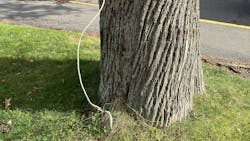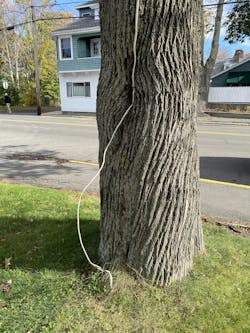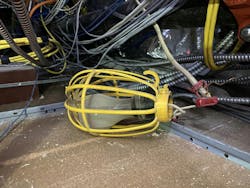Illustrated Catastrophes: An Unfortunate UF Cable Installation
All references are based on the 2023 edition of the NEC.
An Unfortunate UF Cable Installation
While Sec. 225.26 prohibits vegetation such as trees from being used to support overhead conductor spans, installing UF cables up trees in the manner shown in the photo is not specifically prohibited. Section 410.36(G) permits trees to be used as support for outdoor luminaires and associated equipment. Providing some protection for the UF is certainly necessary, however.
A closer look at the UF cable just a few inches above where it emerges from the ground reveals that this UF is all chewed up and damaged. Perhaps a lawn mower or weed trimmer caused this damage. In any case, stapling a UF cable up a tree with no protection against physical damage is a violation of Sec. 340.12(10). Section 300.5(D)(1) requires direct-buried cables emerging from grade to be protected by raceways or other enclosures to a point at least 8 ft above finished grade. This protection must also extend below grade to the minimum cover requirements specified in Table 300.5(A). On a slightly different but related topic, for temporary holiday lighting, the exception for Sec. 590.4(J) does permit trees to support overhead spans of branch-circuit wiring.
Not-So-Temporary Lighting
It’s not very common, but I will sometimes discover a temporary lighting or temporary power installation that was never removed. This temporary light in the photo is a case in point. I found this “temporary” lighting circuit above the suspended ceiling of an office space. The lamp was burned out, but the circuit was still energized long after the job was completed and the space permanently occupied. I traced the circuit, de-energized it, and removed the abandoned wiring.
Section 590.3(D) requires temporary wiring to be removed immediately upon completion of the construction or purpose for which it was installed. In this case, the wiring remained there for several years after the completion of the work. That’s not cool! Thankfully, there were no reported injuries or damage caused by this energized wiring or those free-flying splices.
Temporary wiring is exactly what its name indicates — it is supposed to be temporary. Article 590 relaxes many of the strict provisions required for permanent installations, and, as such, temporary wiring must be disconnected and removed immediately upon completion of its intended use.
About the Author

Russ LeBlanc
Owner
Russ started in the electrical trade as an apprentice in 1985. He worked his way up to become a Journeyman Electrician and then eventually became a Master Electrician and Licensed Construction Supervisor. In 1999 Russ become an Electrical Instructor for The Peterson School of Engineering in Massachusetts where he developed his passion for teaching, and quickly became Department Head of Electrical Instruction. Russ has taught thousands of apprentices, electricians, engineers, inspectors, and other electrical professionals during his career as an instructor. He continues to provide electrical professionals with Electrical Code seminars, Arc-Flash Awareness training seminars and educational material through his LeBlanc Consulting Services in North Reading, MA whose specialty is educating electricians. He has been an active member of the NFPA Electrical Section and has authored hundreds of National Electrical Code proposals and comments which have become Code rules to improve the safety for the electrical industry. Russ is also an IAEI certified Electrical Inspector.
Please visit www.russleblanc.net for more information.


